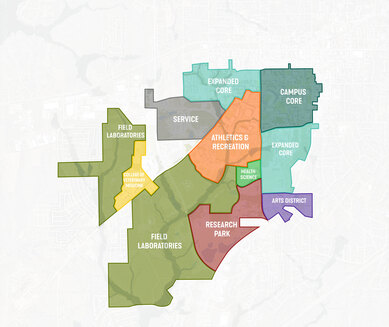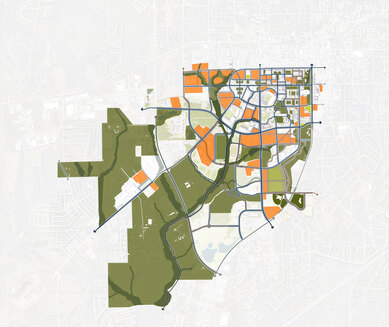Auburn University Campus Development Framework
Known for its lovely traditional core campus, Auburn takes a non-traditional approach with its campus development framework, establishing high-level principles to guide its decision-making.
客户
Auburn University
位置
Auburn, Alabama
市场/服务
Campus Master Plans, Campus Strategy & Analytics, Higher Education
大小
1,800 acres
Chartered as a land-grant institution in 1856, Auburn University has grown into a R1 public university and one of the largest universities in the South. Rather than a comprehensive plan with specific recommendations for growth and development, Auburn sought a less-prescriptive planning tool that would instead codify its guiding principles and how they could be applied to the planning process. The campus planning staff also wanted more active involvement in the plan development, so it would be well prepared to make future updates.

The 2023 Auburn University Campus Development Framework takes a high-level framework approach. It establishes overall design values and goals, which provide meaningful guidelines and guardrails for its future development decisions. These values essentially recognize what is cherished about the Auburn campus—in terms of land use, circulation, open space and other factors—and illustrate how those values can be applied to new development and redevelopment. This approach avoids investing resources in detailed forecasting and maximizes flexibility to keep pace with changing campus needs.
Auburn’s well-designed historic campus core became the hallmark for the plan’s underlying design values and principles. The team studied and measured what works so well here: its unique image and character, its dynamic mix of uses, its building heights and setbacks, its pedestrian-oriented and environmentally friendly circulation routes, its greenspaces and gathering spaces. These characteristics could then be used as the standard to evaluate the entire campus. They helped identify non-conforming aspects of campus (such as underutilized surface parking lots) and how these “opportunity sites” could be put to higher use in keeping with Auburn’s values and principles.

The development framework examines the entire campus at a campus-wide, sector and individual site scales. At the campus-wide level, it provides an understanding of how land is utilized and allocated, with frameworks for preservation areas, existing land use, and circulation routes. The sector level more deeply analyzes each of Auburn’s nine sectors, mapping out an opportunity plan for how the newly defined design values and principles can be applied to growth and improvements. Finally, the site level hones in on three specific projects with the greatest and most imminent development potential, providing more detailed guidance for appropriate uses.
SmithGroup and Auburn’s Campus Planning and Space Management team worked in close collaboration through every step of the plan’s development. Weekly meetings and a shared platform for preparing and reviewing plan documents kept everyone on track and working simultaneously toward completion. It ensured that Auburn staff had the foundation and the metrics to use the development framework as intended—a working tool that will guide wise decisions on campus development for years to come.
